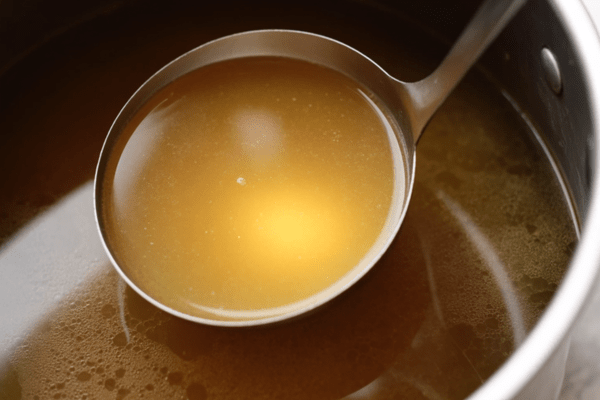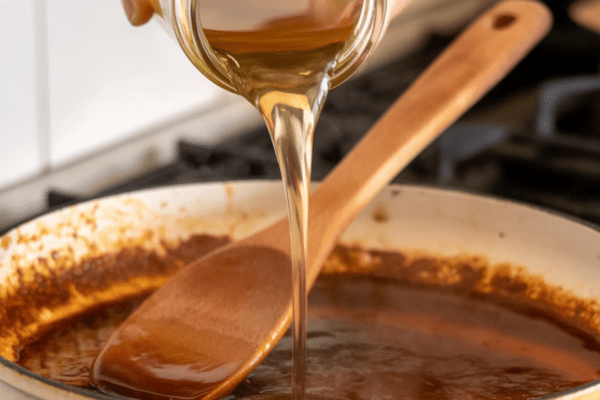There’s something truly magical about homemade chicken stock — not just because it transforms everyday recipes into restaurant-quality meals, but because it brings out the best in whatever you’re cooking, from cozy soups to rich gravies and silky sauces. If you’ve only ever used store-bought broth, you’re in for a treat. This recipe produces a clear, unsalted, full-bodied chicken stock with unmatched depth and richness.

And the best part? It’s mostly hands-off. Just toss everything in a pot and let it work its quiet magic on the stovetop.
Why You’ll Love This Chicken Stock
- Deep, pure flavor – Way beyond what a boxed stock can offer.
- Naturally rich and gelatinous – Thanks to the bones, not additives.
- No added salt – Gives you full control over your final dish.
- Freezable – A few hours of work yields weeks (or months) of flavor boosters.
What You’ll Need
Chicken bones (carcasses):
Use raw chicken carcasses (a.k.a. frames). These are stripped chicken skeletons with just a bit of meat left—ideal for extracting flavor and collagen without greasiness.
Aromatics:
- 1 onion (peeled and halved)
- 1-2 carrots (roughly chopped)
- 2 celery ribs (roughly chopped)
- 3 garlic cloves (smashed, skins on)
- A small bunch of parsley stems
- 1 bay leaf
- 3 sprigs of thyme (or substitute dried thyme)
- ½ tsp whole black peppercorns
Other additions:
- A splash (1 tbsp) apple cider vinegar – helps draw nutrients from the bones
- 3 litres (about 12 cups) cold water – enough to just cover everything

Step-by-Step: How to Make Chicken Stock
1. Add everything to a pot
Place the bones and all vegetables, herbs, and vinegar in a large 7-litre (or larger) pot. Cover with water.
2. Bring to a simmer
Over medium-high heat, bring the mixture to a gentle simmer, not a boil. This helps keep the stock clear.
3. Skim the scum
As the liquid heats up, foam (impurities) will rise to the top. Skim this off with a spoon and discard. Doing this helps keep your stock clear and clean-tasting.
4. Simmer uncovered for 3 hours
Reduce heat to low. Let it bubble gently for 3 hours, uncovered. Don’t stir—just let it simmer slowly.
5. Strain the stock
Use a fine mesh strainer to pour the liquid into another large pot or heatproof bowl. Discard the bones and veggies (they’ve given up all their flavor).
6. Cool and store
Let the stock cool slightly. Pour into jars or freezer containers in 1-cup or 2-cup portions. Once cooled to room temperature, chill in the fridge.
The Gelatin Test: Good Stock Should Wiggle
Once fully chilled, the stock will turn jelly-like—this is a sign of high gelatin content and a well-made stock. The fat will form a solid white layer on top. You can:
- Skim it off for a lighter stock (ideal for clear soups or reductions).
- Leave some if using for stews or creamy sauces where a bit of richness is welcome.
Storage Tips
- Refrigerator: Keeps for up to 5 days.
- Freezer: Keeps for 6 months.
- Portion wisely: Freeze in silicone muffin trays or ice cube trays for quick grab-and-use options.
FAQs
Can I use roast chicken bones (like from a rotisserie)?
They won’t produce enough flavor alone. Stick with raw carcasses for best results.
Can I make it in a slow cooker?
Yes! Set on low for 8–10 hours. Skim at the beginning if needed.
Do I need to peel the vegetables?
Nope. Just give them a good rinse. The peels add flavor and color.
Can I reuse the bones?
Not for another batch of stock—most of the flavor and nutrients are extracted after one simmer.

Ways to Use Your Chicken Stock
Homemade chicken stock is liquid gold in recipes like:
- Chicken noodle soup
- Creamy risotto
- Gravy and pan sauces
- Rice dishes (replace water with stock for extra flavor)
- Stews and braises
- Mashed potatoes (use stock instead of cream for a lighter option)
Final Thoughts
Homemade chicken stock might sound like something only chefs and food nerds do—but once you try it, you’ll never want to go back to the store-bought stuff. It’s easy, budget-friendly, and makes every dish you add it to just taste better. Whether you’re simmering a simple soup or building a hearty stew, this is the foundation that lifts it all up.
Make a big batch, freeze it, and your future self will thank you every time you reach for a jar.
Basic Chicken Stock

There’s something special about making your own chicken stock. It fills the whole kitchen with that rich, savory aroma and turns even simple soups, sauces, or risottos into something that tastes like it came from a professional kitchen.
Ingredients
- 2 kg/4 lb chicken frames (ie carcass), raw
- 1 carrot (medium), unpeeled, cut into 4 equal pieces
- 1/2 onion, peeled and halved
- 1/2 tbsp black peppercorns
- 2 bay leaves, fresh (or 1 dried)
- 1 celery stem, cut in four (use the leaves too)
- 1 tbsp apple cider vinegar
- 2 thyme sprigs (or 1/2 tsp dried leaves)
- 3 parsley sprigs
- 3 litres / 3 quarts water (just tap water, cold)
Instructions
- Grab a large stockpot big enough to hold everything comfortably. Add in all the chicken frames, chopped carrot, onion, celery, peppercorns, vinegar, bay leaves, thyme, parsley, and the cold water. The water should just about cover the bones so everything is nicely submerged.
- Put the pot on medium-high heat and slowly bring it up to a boil. As it starts bubbling, you’ll notice some foam rising to the surface—just skim that off with a ladle and discard it. This step helps you get a nice, clear stock.
- Once it’s boiling, turn the heat way down to low. You want it to just barely bubble, with only the gentlest movement on the surface.
- A slow, gentle simmer is the secret to keeping the stock clear and full-flavored without getting cloudy. Let it go like this for about three hours uncovered.
- When it’s finished, use a lid to hold back the bones and veggies and carefully pour the stock through a fine sieve into another large pot or bowl. If you prefer, you can scoop out the solids with a slotted spoon first, then strain the liquid for extra clarity.
- You should have around 2 litres of rich, golden stock. If you ended up with too much, just simmer it gently until it reduces to about 2 litres so it’s nice and concentrated. If you have a little less, you can top it off with water.
- Pour the stock into containers in measured amounts (I usually do 1-cup portions) to help it cool quickly and make storage easy.
- Let it cool on the counter before refrigerating. Once chilled, the fat will rise to the top and solidify—just scrape it off and discard it before using.
Notes
- Chicken carcasses are the leftover bones and cartilage after the meat has been removed. They’re easy to find and affordable at many butchers and even grocery stores. They have the perfect balance of meat, bone, and fat to give you a rich, flavorful, nutrient-packed stock.
- It’s a wonderfully clear stock that works in just about any recipe. You can use other chicken cuts too, but they’ll give you a slightly different flavor and consistency.
Nutrition Information
Yield
2Serving Size
1Amount Per Serving Calories 2052Total Fat 119gSaturated Fat 33gTrans Fat 0gUnsaturated Fat 73gCholesterol 853mgSodium 735mgCarbohydrates 13gFiber 2gSugar 8gProtein 219g
All Chicken Recipes.com, occasionally offers nutritional information for recipes contained on this site. This information is provided as a courtesy and is an estimate only. This information comes from online calculators. Although allchickenrecipes.com attempts to provide accurate nutritional information, these figures are only estimates.
